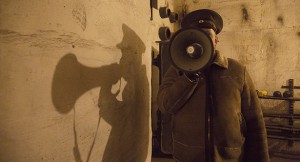Romanian Cultural Institute at the Venice Biennale 2015
Inventing the Truth. On Fiction and Reality
9 May–22 November 2015
Press and professional preview: 6–8 May
Opening: Friday, 8 May, 5pm; The Finnish Method, performance by Alex Mirutziu at 5:30pm
The New Gallery of the Romanian Institute for Culture and Research in Humanities
Campo Santa Fosca
Palazzo Correr
Cannaregio 2214
30121 Venice
Commissioner: Monica Morariu
Deputy Commissioner: Alexandru Damian
Project management and communication: Ephemair Association, Bucharest
Artists: Michele Bressan, Carmen Dobre-Hametner, Alex Mirutziu, Lea Rasovszky, Stefan Sava, Larisa Sitar
Curator: Diana Marincu
The exhibition Inventing the Truth. On Fiction and Reality will represent Romania at the 56th International Art Exhibition – Venice Biennale at the New Gallery of the Romanian Institute, alongside Darwin’s Room by Adrian Ghenie in the National Pavilion in Giardini.
The exhibition took shape along two simultaneous directions of research, one of which interprets fiction as the “repressed” part of the discourse of history (as defined by Michel de Certeau), while the other focuses on the seemingly banal everyday, where quotidian elements are poetically re-contextualised and temporally recomposed by means of fiction. The transformation of the past into the solid substance of history is always an act of excess, a political gesture, a subjective intrusion on the part of those researching an archive. Therefore, the works presented here enrich the analysis of history through the insertion of fiction and personal micro-histories. However, the present provides even greater interpretative versatility and a better dynamics of narrative construction thanks to real-time revisions and corrections.
The works on show bring to the fore both the interpretative process and the production of such narratives. The visual construction of each project engages with the conventions of fiction, making visible the traces of the author and the subtle joins linking authenticity and invention. The impossibility of identifying the limits of reality leads the viewer to waver between how convincing and how jarring the mise-en-scène is.
Carmen Dobre-Hametner‘s (b. 1978) photographic project Consuming History documents the commercial re-enactment of everyday life in communism, organized in a former Soviet bunker near Vilnius, and made available for tourists and locals; the photographs reflect on contemporary perceptions of history and otherness. Stefan Sava (b. 1982) proposes a video essay on the potential and the limits of interpreting a personal photographic archive, questioning the representation of a traumatic past. The work And then one thing led to another… by Larisa Sitar (b. 1984) speaks of exchanges between ideology and history by appropriating differently dated engravings that depict violence, ruin and nameless figures that influenced the course of human history. Michele Bressan (b. 1980) speculates on the temporal displacement of an event, rendering it more abstract and suspending it outside chronological conventions. Lea Rasovszky (b. 1986) puts together a story from fragments of real events, personal memories and excerpts from books, integrating fiction into the narrator’s own life. Alex Mirutziu (b. 1981) uses the concepts of the “bureaucratic object” and “ontological design” in the relations he establishes between word and space, body and object.
Image: Carmen Dobre-Hametner, Consuming History, 2015. Digital photograph, 30.2 x 55.9 cm. Courtesy of the artist.


